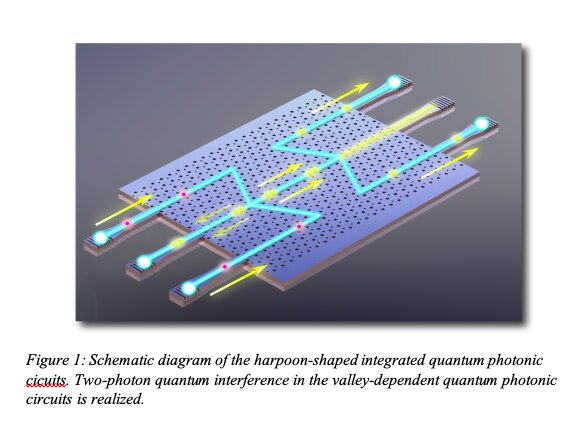프레스센터
The realization of topologically protected valley-dependent quantum photonic chips
2021-07-14 11:57:16 조회 :898
The realization of topologically protected valley-dependent quantum photonic chipsCredit: Chen et al The field of topological photonics, specialized in the development of a class of materials known as photonic topological insulators, has advanced considerably over the past few decades. Photonic topological insulators have many promising qualities, including the ability to control the flow of classic light. Researchers at the University of Science and Technology of China, Sun Yat-sen University and Zhejiang University have recently designed and fabricated topologically protected valley-dependent quantum nanophotonic circuits. These circuits, presented in a paper published in Physical Review Letters, demonstrate the potential of leveraging the so-called photonic valley state to realize quantum information processing applications. A part of the research team, led by Jian-Wen Dong at Sun Yat-sen University, previously showed that valley photonic crystals could be a highly efficient platform for realizing topologically protected robust light transport on compact silicon chips, which could in turn also be useful to achieve on-chip quantum information processing. Another part of the team, led by Xi-Feng Ren at the University of Science and Technology of China, has conducted extensive research focusing on the development of quantum integrated photonic circuits. Recently, these two teams started collaborating on research aimed at merging the fields of topological photonics and quantum optics. As part of their recent study, they specifically set out to develop topologically protected valley-dependent quantum photonic circuits. "In recent years, people begun to utilize topological photonic structures in quantum information field, such as the generation of quantum states, topological protection of quantum coherence, etc.," Jian-Wen Dong and Xi-Feng Ren, two of the researchers who carried out the recent study, told Phys.org. "However, previous works typically used waveguide arrays to build topological photonic structures, which restricts the scaling up of circuits and flexible modulation of quantum states." Dong, Ren and their colleagues designed and fabricated a nanophotonic harpoon-shaped beam splitter (HSBS) that is small and compact. In addition, they realized a high visibility two-photon quantum interference using this type of circuit for the very first time. Notably, their study introduces a strategy to use valley degree of freedom to achieve on-chip quantum information processing in a robust way and using a compact chip. "The key goal of our work was to realize quantum interference with a topologically protected valley-dependent beam splitter," Dong and Ren said. "As the most important structure, the harpoon-shaped beam splitter was formed by two kinds of hexagonal-profile air holes, which are fabricated on SOI wafers with 220-nm-thick silicon layers by electron-beam lithography." Compared to previously developed topological quantum photonic circuits, the HSBS created by Dong, Ren and their colleagues are CMOS compatible, scalable and easier to integrate in devices. These qualities could make them easier to use for large-scale quantum information processing implementations. "We believe our paper can significantly promote the convergence of topological photonics and quantum optics, raising widespread interest in these two fields," Dong and Ren said. The researchers' realization of on-chip quantum information processing could open up new possibilities for the use of topological photonics to create real devices. In addition, their paper highlights the value of valley-dependent topological edge states for achieving robust quantum information processing on silicon chips. "In the future, we ultimately aim to develop a quantum information processing chip based on topological nanophotonics," Dong and Ren added. "In the near term, we will continue to explore valley photonic crystals on quantum photonic sources and more complex quantum photonic circuits." |

























